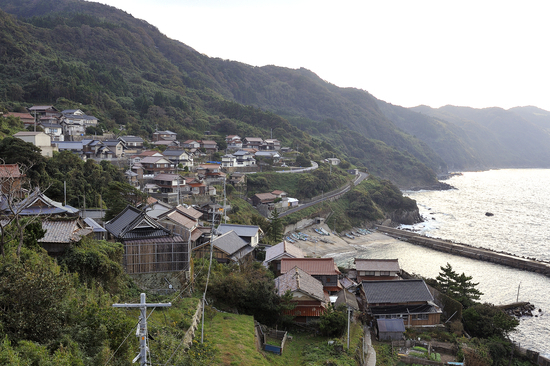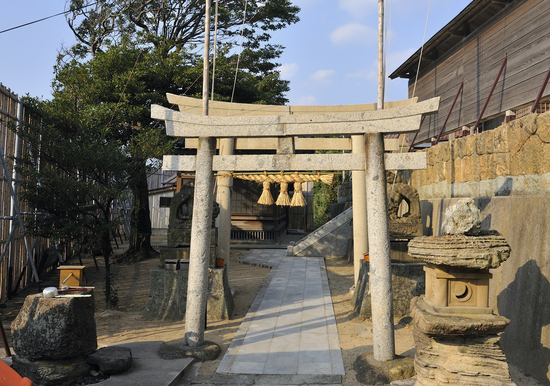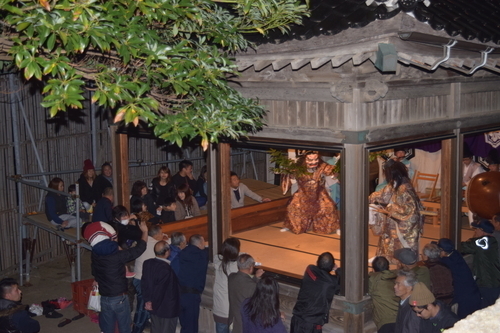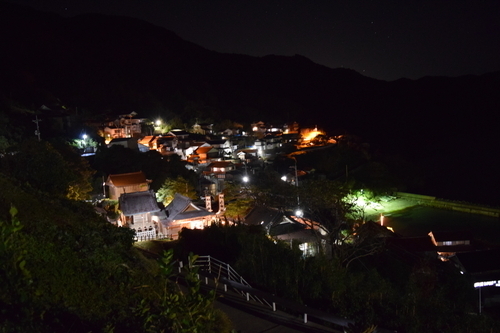Onoze-ura
| Bay Name | Onoze-ura |
|---|---|
| Shrine Name | Hachioji gongen (Former) Yakami-jinja (Current) |
| Deity |
Agakatsu-no-mikoto Amenohohi-no-mikoto etc 8 kami (gods) |
| Location |
Matsue-shi Onozecho 1175 |
Onoze Hachioji gongen
Moshioyaku shizu no Onose-ura tsutai
kemuri zonabiku Asa no yuunani

Onoze village faces out onto Meshima Island and the large Eboshi-iwa rock formation. It provides the perfect vantage point for fishing hence ‘Onoze’ (lit. fish shoals) being a very fitting name for this bay.
However, the word ‘onoze’ also has a connection with an ancient town name from this area, ‘Oono’. The likely development of the name comes first from a miscommunication from the original sound ‘Oo-no-se’ , to ‘Onoze’ and eventually to the naming/characters used today.
Regarding the shoreline from the west side of the Etomo Gulf to Tatenui District, the Fudoki states: " The beach, located between the rocks in the west and the cape of Shimo, the border of the Tatenui district, is very craggy and treacherous. It is so rough that there is no place for ships to anchor, even when winds aren't high." This stretch is thought to have been the most challenging and risky for the pilgrims undertaking the 42 Bay mission crossing from east to west. This area gives us some idea of the hardships they must have endured. "
The shrine already had its old name, ‘Hachioji-gongen’ by the time of the Kyoho Era period publication, the Unyoshi. The renaming to Yakami-jinja took place in 1871. In 1912, it was enshrined together with Mishima Myoujin (deity Kotoshironushi) of Mishima island which had been listed in the Fudoki. An account of a visit to Ooshima, "Year 2 of Man en (1861) ", written by the representative poet of the Bakamatsu Matsue Clan , Moritame Yasushi, still remains today. At present, a Mishima Myojin shrine is enshrined within the current main shrine grounds.
It is not known why Hachioji is deified here, but legend has it that the ‘Eight kami’(gods) were established as 'founding' gods into this area. The story goes that eight sailors dispatched as part of daimyo Hideyoshi’s Korean Invasion ended up becoming stranded at Onoze. Each of them performed a ceremonial transfer of the deity of their hometowns and began worshipping them, leading to the start of the eight kami enshrinement. Even today, descendents of the sailors perform rituals in memory of their ancestors.

To get to Yakami-jinja: Head east from Sazuchi shrine in Ino-ura, keep going over the mountain and then continue east again when you get to the three forked junction (heading west will take you in the direction of Hirata). Take the left road at the following three lane junction. Next, with the Sea of Japan on your left, take the narrow road and go right through the small village. Head left keeping the Onoze Post office on your right and when the winding road eventually straightens, you will reach the shrine.
Onoze used to be so secluded that is was a real struggle to get there whichever road was taken. However, following the construction of the Onoze Tunnel and Ebisu Bridge in March 2012, it is now considerably easier to access from Aika machi in Matsue City. From here, go through the aforementioned tunnel, take the left at the large Y-section, head east through the Mubou Tunnel, pass by the rows of cherry blossom trees and you'll end up at Ko-ura with its Tenmangu Shrine on the left as you enter the main town.
The Onoze Tondo (New Year festival) take place on Coming-of-Age-Day. Fishermen carry model boats adorned with bamboo decorations holding Ebisu and Daikoku gods and together with Toshitoku-gami, the new year god, they parade through the town. In the evening, all the decorations are taken down and along with the remaining wooden frame of the boat, everything is burnt as an offering to the gods.
The Yakami-jinja (shrine) reconstruction in Onoze follows the tradition of transferring the sacred object of worship (Go Shintai) in the O-mikoshi (portable shrine) carried on the shoulders of eight people representing the head family from ancient times. Ebisu and Daikoku are the protector gods of the West and East of Onoze. In addition, Ebisu the kami (god) of fishing and Daikoku, the kami of fortune. These venerable kami are also the origin of the name of the Ebisu Daikoku Bridge which follows on from the Onoze Tunnel. Every year around the 18th of October from about 8 p.m. to 11 p.m. , there is a Fall festival where members of the Taito-town kagura (Shinto theater) troupe collect the sacred sakaki tree and perform stories and myths such as Kuniyuzuri (Transfer of the Land), on the Kagura stage within the shrine grounds. The festival also includes a 'mochimaki ' event where rice cakes are thrown down to the crowds from a red/white decorated platform depicting the colors associated with auspicious occasions. This festival is a well-attended, popular event and offers beautiful views of the town on the return journey.


| Bay Name | Onoze-ura |
|---|---|
| Shrine Name | Hachioji gongen (Former) Yakami-jinja (Current) |
| Deity |
Agakatsu-no-mikoto Amenohohi-no-mikoto etc 8 kami (gods) |
| Location |
Matsue-shi Onozecho 1175 |
Onoze Hachioji gongen
Moshioyaku shizu no Onose-ura tsutai
kemuri zonabiku Asa no yuunani
Onoze village faces out onto Meshima Island and the large Eboshi-iwa rock formation. It provides the perfect vantage point for fishing hence ‘Onoze’ (lit. fish shoals) being a very fitting name for this bay.
However, the word ‘onoze’ also has a connection with an ancient town name from this area, ‘Oono’. The likely development of the name comes first from a miscommunication from the original sound ‘Oo-no-se’ , to ‘Onoze’ and eventually to the naming/characters used today.
Regarding the shoreline from the west side of the Etomo Gulf to Tatenui District, the Fudoki states: " The beach, located between the rocks in the west and the cape of Shimo, the border of the Tatenui district, is very craggy and treacherous. It is so rough that there is no place for ships to anchor, even when winds aren't high." This stretch is thought to have been the most challenging and risky for the pilgrims undertaking the 42 Bay mission crossing from east to west. This area gives us some idea of the hardships they must have endured. "
The shrine already had its old name, ‘Hachioji-gongen’ by the time of the Kyoho Era period publication, the Unyoshi. The renaming to Yakami-jinja took place in 1871. In 1912, it was enshrined together with Mishima Myoujin (deity Kotoshironushi) of Mishima island which had been listed in the Fudoki. An account of a visit to Ooshima, "Year 2 of Man en (1861) ", written by the representative poet of the Bakamatsu Matsue Clan , Moritame Yasushi, still remains today. At present, a Mishima Myojin shrine is enshrined within the current main shrine grounds.
It is not known why Hachioji is deified here, but legend has it that the ‘Eight kami’(gods) were established as 'founding' gods into this area. The story goes that eight sailors dispatched as part of daimyo Hideyoshi’s Korean Invasion ended up becoming stranded at Onoze. Each of them performed a ceremonial transfer of the deity of their hometowns and began worshipping them, leading to the start of the eight kami enshrinement. Even today, descendents of the sailors perform rituals in memory of their ancestors.
To get to Yakami-jinja: Head east from Sazuchi shrine in Ino-ura, keep going over the mountain and then continue east again when you get to the three forked junction (heading west will take you in the direction of Hirata). Take the left road at the following three lane junction. Next, with the Sea of Japan on your left, take the narrow road and go right through the small village. Head left keeping the Onoze Post office on your right and when the winding road eventually straightens, you will reach the shrine.
Onoze used to be so secluded that is was a real struggle to get there whichever road was taken. However, following the construction of the Onoze Tunnel and Ebisu Bridge in March 2012, it is now considerably easier to access from Aika machi in Matsue City. From here, go through the aforementioned tunnel, take the left at the large Y-section, head east through the Mubou Tunnel, pass by the rows of cherry blossom trees and you'll end up at Ko-ura with its Tenmangu Shrine on the left as you enter the main town.
The Onoze Tondo (New Year festival) take place on Coming-of-Age-Day. Fishermen carry model boats adorned with bamboo decorations holding Ebisu and Daikoku gods and together with Toshitoku-gami, the new year god, they parade through the town. In the evening, all the decorations are taken down and along with the remaining wooden frame of the boat, everything is burnt as an offering to the gods.
The Yakami-jinja (shrine) reconstruction in Onoze follows the tradition of transferring the sacred object of worship (Go Shintai) in the O-mikoshi (portable shrine) carried on the shoulders of eight people representing the head family from ancient times. Ebisu and Daikoku are the protector gods of the West and East of Onoze. In addition, Ebisu the kami (god) of fishing and Daikoku, the kami of fortune. These venerable kami are also the origin of the name of the Ebisu Daikoku Bridge which follows on from the Onoze Tunnel. Every year around the 18th of October from about 8 p.m. to 11 p.m. , there is a Fall festival where members of the Taito-town kagura (Shinto theater) troupe collect the sacred sakaki tree and perform stories and myths such as Kuniyuzuri (Transfer of the Land), on the Kagura stage within the shrine grounds. The festival also includes a 'mochimaki ' event where rice cakes are thrown down to the crowds from a red/white decorated platform depicting the colors associated with auspicious occasions. This festival is a well-attended, popular event and offers beautiful views of the town on the return journey.






